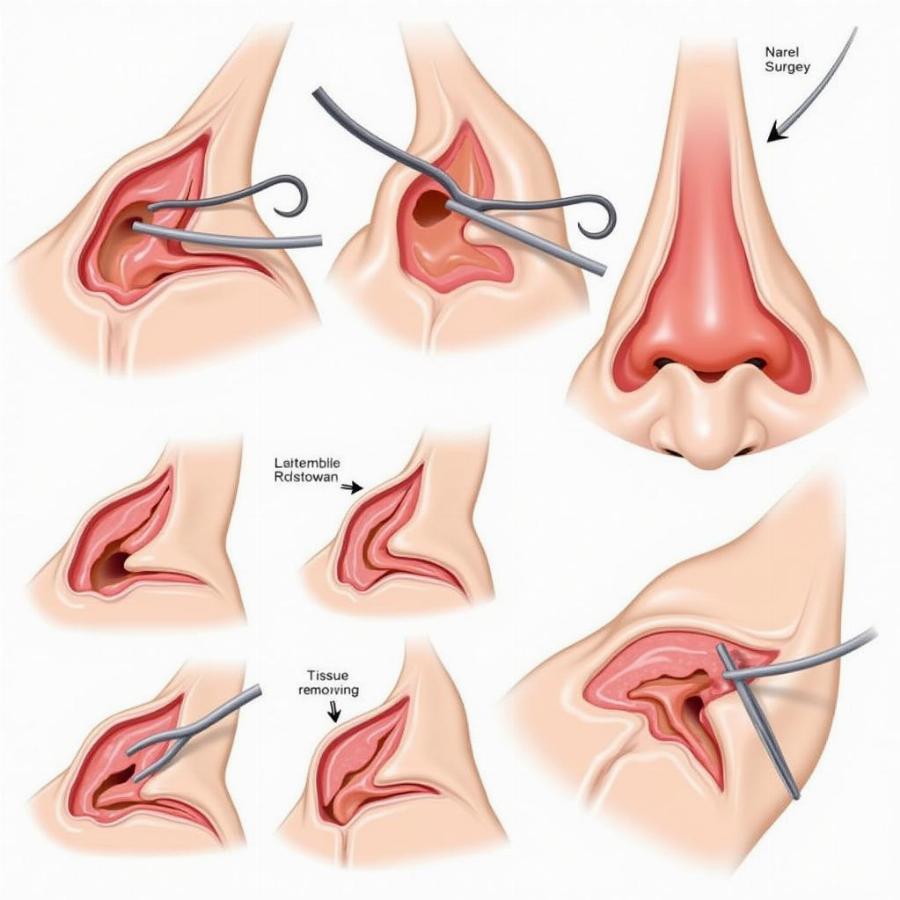Nares surgery in dogs, specifically for brachycephalic breeds, is a common procedure aimed at improving their breathing. This article will delve into the details of nares surgery, covering everything from why it’s necessary, the procedure itself, recovery, and potential complications. Understanding this procedure is crucial for brachycephalic dog owners who want to ensure their furry friends live a comfortable and healthy life.
Understanding Nares Surgery in Dogs
Brachycephalic breeds, such as Bulldogs, French Bulldogs, and Pugs, are adorable with their short snouts and wrinkled faces. However, this cute feature often comes with breathing difficulties due to narrowed nostrils (stenotic nares). Nares surgery, also known as nare resection or rhinoplasty, is a surgical procedure that widens the nostrils, allowing for improved airflow and easier breathing.
Why is Nares Surgery Necessary?
Stenotic nares restrict the amount of air a dog can inhale, making it difficult for them to breathe normally. This can lead to a variety of health problems, including:
- Noisy breathing: Snorting, snoring, and wheezing are common signs of restricted airways.
- Exercise intolerance: Difficulty breathing makes it hard for dogs to exercise, leading to a sedentary lifestyle and potential weight gain.
- Heatstroke: Brachycephalic breeds are particularly susceptible to heatstroke because they struggle to regulate their body temperature through panting.
- Cyanosis: In severe cases, lack of oxygen can lead to a bluish discoloration of the gums and tongue.
Nares surgery can significantly improve a dog’s quality of life by alleviating these breathing problems.
The Nares Surgery Procedure
Nares surgery is typically performed under general anesthesia. The veterinarian will make small incisions in the nostrils to remove a wedge of tissue, widening the nasal openings. The incisions are then closed with sutures.  Surgical process of nares surgery soft palate surgery dog is often performed in conjunction with nares surgery to further improve breathing in brachycephalic breeds.
Surgical process of nares surgery soft palate surgery dog is often performed in conjunction with nares surgery to further improve breathing in brachycephalic breeds.
What to Expect After Nares Surgery
After surgery, your dog will need a few weeks to recover. Your veterinarian will provide pain medication and antibiotics to prevent infection. It’s crucial to keep the surgical site clean and dry to promote healing. You may notice some swelling and bruising around the nostrils, which is normal and should subside within a few days.
Potential Complications of Nares Surgery
While nares surgery is generally safe and effective, there are some potential complications, including:
- Infection: Keeping the surgical site clean is crucial to minimize the risk of infection.
- Bleeding: Some bleeding is normal after surgery, but excessive bleeding should be reported to your veterinarian immediately.
- Scarring: While the incisions are small, some scarring is inevitable.
- Narrowing of the nostrils: In rare cases, the nostrils may narrow again over time, requiring a repeat surgery.
Long-Term Benefits of Nares Surgery
Nares surgery can significantly improve the quality of life for brachycephalic dogs, allowing them to breathe easier, exercise more comfortably, and regulate their body temperature more effectively. It can also reduce the risk of serious health problems like heatstroke and cyanosis.
FAQs About Nares Surgery in Dogs
- How much does nares surgery cost? The cost of nares surgery varies depending on the veterinarian and location, but it typically ranges from a few hundred to a thousand dollars.
- How long does nares surgery take? The procedure itself usually takes less than an hour.
- When can my dog go home after nares surgery? Most dogs can go home the same day or the day after surgery.
- What are the signs of complications after nares surgery? Signs of complications include excessive bleeding, swelling, discharge, or difficulty breathing.
- Is nares surgery always successful? While nares surgery is generally effective, it’s not always a complete cure. Some dogs may still experience some breathing difficulties, especially during strenuous exercise or hot weather.
- What is the recovery time for nares surgery? Most dogs recover fully within a few weeks.
- Are there alternatives to nares surgery? In some mild cases, lifestyle changes, such as weight management and avoiding strenuous exercise, may be sufficient. However, surgery is often the best option for dogs with significant breathing difficulties. soft palate operation for dogs might also be a consideration.
Conclusion
Nares surgery is a valuable procedure that can dramatically improve the life of brachycephalic dogs struggling with breathing issues. By understanding the procedure, recovery process, and potential complications, you can make an informed decision about whether nares surgery is the right choice for your furry friend.
Beaut Dogs is your trusted source for all things related to dog care. We are dedicated to providing valuable and insightful information to help you care for your beloved canine companions. For further assistance and personalized advice, please contact us at Email: [email protected]. Beaut Dogs is here to help you navigate the world of dog ownership with confidence. Visit us at https://beautdogs.com.